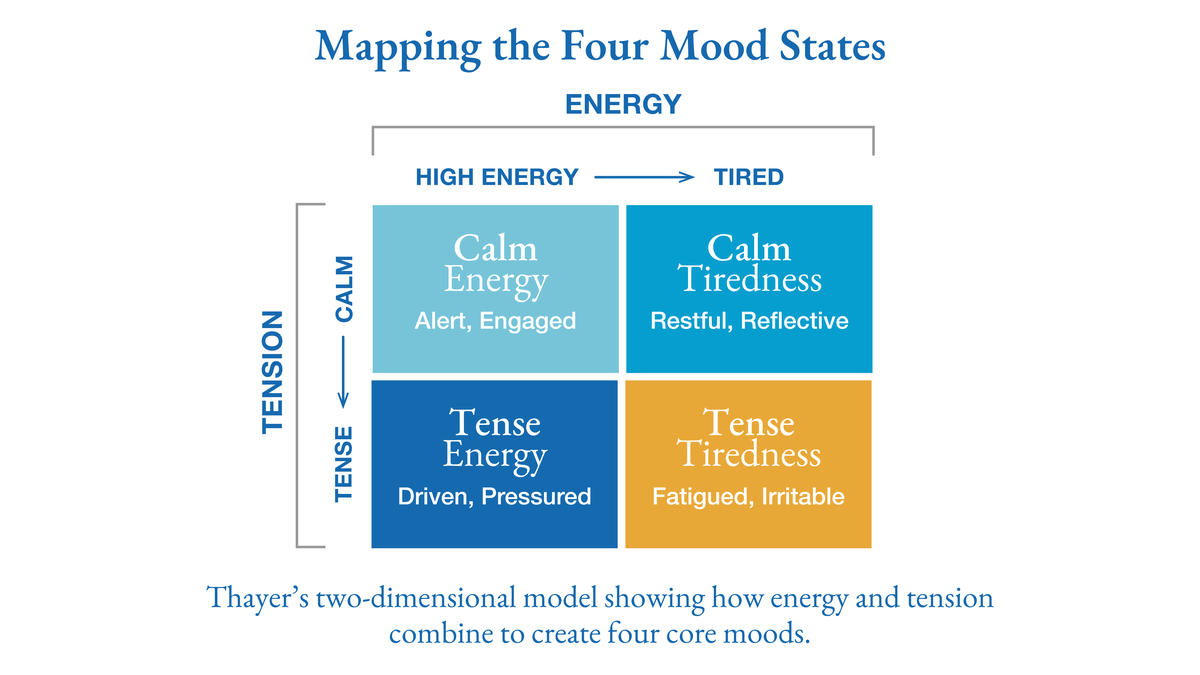Energy and Tension Impact Us Every Day
Our inner state can shift without any obvious cause. We may start the day feeling upbeat and focused, yet by mid-morning find ourselves tense, distracted, or oddly depleted. These subtle mood shifts shape how we think, behave, and connect—often more than we realize.
One reason we’re unaware of what drives these changes is that mood is multifactorial. It’s influenced by sleep, activity, diet, environment, and—beneath them all—the quiet interplay between energy and tension.
Studying this invisible rhythm became the lifelong work of psychologist Robert E. Thayer, whose findings remain deeply relevant for understanding stress, productivity, and emotional health.
Tracking Mood in Real Time
At California State University, Long Beach, Thayer spent more than fifty years studying what he called the psychology of everyday moods.
Using then-innovative experience sampling, he asked participants to record their energy, tension, and activities whenever they were randomly signaled during the day. These real-time observations revealed that moods follow distinct physiological and behavioral rhythms—patterns linked to lifestyle, movement, and environment.
From this work, Thayer identified a simple but powerful framework: our daily moods can be mapped along two key dimensions—energy (high or low) and tension (high or low). Together, these form four predictable mood states.
The Four Core Mood States
1. Calm Energy (High Energy, Low Tension)
This is the optimal zone—a state of alert relaxation where focus, creativity, and confidence align.
People here feel “in the zone”: engaged yet grounded, motivated yet composed. Thayer found that this state produced the highest moods, clearest thinking, and best interpersonal connection.
2. Calm Tiredness (Low Energy, Low Tension)
This is the recovery zone—a mellow, restorative state that allows body and mind to recharge. It can feel like the peaceful exhale after meaningful work or the calm that follows reflection.
When tiredness arrives at the right time—after work or before sleep—it’s satisfying. When it comes too early, it feels dull and unproductive. Building planned rest into your day converts fatigue into restoration rather than frustration.
3. Tense Energy (High Energy, High Tension)
This is the “wired and driven” state—pressured but productive. In short bursts, it boosts focus and performance.
Thayer found that moods stay relatively high here because energy buffers stress. The key is duration: ride the productive wave, then disengage before exhaustion sets in.
4. Tense Tiredness (Low Energy, High Tension)
This is the most draining state—when the body is fatigued but the mind can’t relax. Irritability, anxiety, and frustration dominate.
Thayer noted three common patterns: (1) most negative moods occur here; (2) people instinctively reach for quick fixes—caffeine, sugar, alcohol, or scrolling; and (3) those fixes often appear before the low hits, as people sense depletion coming.

Thayer’s Framework in Modern Life
Thayer’s model feels prophetic in our era of digital overload and burnout. Each mood state mirrors a modern pattern:
- Calm Energy fuels mindfulness, flow, and creative focus.
- Calm Tiredness reflects the growing appreciation for rest and recovery.
- Tense Energy captures our high-pressure productivity mode—the challenge is knowing when to step out.
- Tense Tiredness describes our collective fatigue—overstimulated yet drained, restless but unfulfilled.
Recognizing which state you’re in allows early course correction: to walk instead of reach for coffee, breathe instead of scroll, or shift your environment before tension overwhelms.
The Actionable Lesson of Each State
Understanding the four states is one thing; knowing what to do inside them is another. Each holds a distinct lesson about self-regulation:
- Calm Energy — Protect the Flow
Guard this zone like a precious resource. Silence pings, avoid multitasking, and channel your best energy toward high-value work and connection. - Calm Tiredness — Embrace the Restoration
This is your cue for recovery. Don’t mistake low energy for boredom or failure. Lean into the calm—stretch, breathe, or rest without guilt. - Tense Energy — Manage the Duration
Use this driven intensity for priorities, but set a clear exit point. When tension builds, deliberately downshift—step outside, move, or switch to lighter tasks to prevent the slide into exhaustion. - Tense Tiredness — Trigger the Reset
Here, thinking harder doesn’t work. Interrupt the loop physically: take a brief walk, breathe slowly, or listen to music. The goal isn’t motivation—it’s relief and reset.
The Imperative to Become an Energy Manager
All the lessons from Thayer’s model converge on one truth: energy management is a central lever for governing mood.
That insight has never been more relevant. Modern life—24/7 connectivity, competitive work demands, constant digital stimulation, and chronic sleep loss—keeps tension high while steadily draining energy. The result is a perfect breeding ground for tense tiredness: overstimulated yet exhausted, restless but unfulfilled.
To adapt, we must invest more deliberately in how we build and manage energy. To do so, invest in all the key domains of human vitality: physical, emotional, social, purpose-driven, mental, and spiritual. These six domains are explored throughout this site.
Equally important is mastering the energy reset—restoring energy before it runs low. Short, energetic “micro-resets” that help you stay in calm energy, use tension productively, and prevent fatigue are plentiful, but their power lies in how you apply them. In my next blog, we’ll explore practical energy resets you can use throughout the day to restore balance and vitality.



